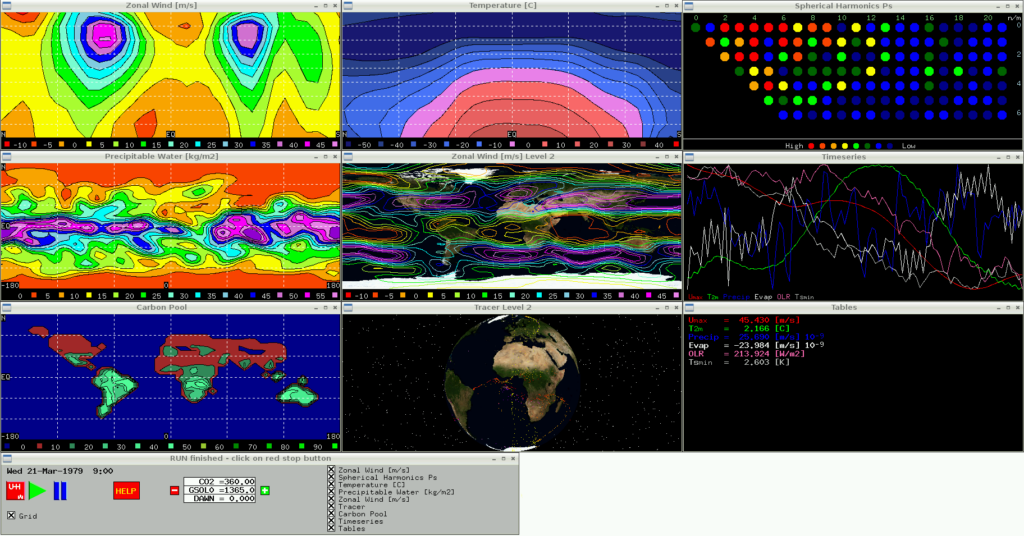Here’s this morning’s announcement of The 2021 Nobel Prize in Physics from the Royal Swedish Academy of Sciences in Stockholm in full:
The associated press release puts it this way:
The Royal Swedish Academy of Sciences has decided to award the Nobel Prize in Physics 2021
“for groundbreaking contributions to our understanding of complex physical systems”
with one half jointly to Syukuro Manabe, Princeton University, USA and Klaus Hasselmann, Max Planck Institute for Meteorology, Hamburg, Germany
“for the physical modelling of Earth’s climate, quantifying variability and reliably predicting global warming”
and the other half to Giorgio Parisi, Sapienza University of Rome, Italy
“for the discovery of the interplay of disorder and fluctuations in physical systems from atomic to planetary scales”
The press release explains:
Complex systems are characterised by randomness and disorder and are difficult to understand. This year’s Prize recognises new methods for describing them and predicting their long-term behaviour.
One complex system of vital importance to humankind is Earth’s climate. Syukuro Manabe demonstrated how increased levels of carbon dioxide in the atmosphere lead to increased temperatures at the surface of the Earth. In the 1960s, he led the development of physical models of the Earth’s climate and was the first person to explore the interaction between radiation balance and the vertical transport of air masses. His work laid the foundation for the development of current climate models.
About ten years later, Klaus Hasselmann created a model that links together weather and climate, thus answering the question of why climate models can be reliable despite weather being changeable and chaotic. He also developed methods for identifying specific signals, fingerprints, that both natural phenomena and human activities imprint in he climate. His methods have been used to prove that the increased temperature in the atmosphere is due to human emissions of carbon dioxide.
Around 1980, Giorgio Parisi discovered hidden patterns in disordered complex materials. His discoveries are among the most important contributions to the theory of complex systems. They make it possible to understand and describe many different and apparently entirely random materials and phenomena, not only in physics but also in other, very different areas, such as mathematics, biology, neuroscience and machine learning.
“The discoveries being recognised this year demonstrate that our knowledge about the climate rests on a solid scientific foundation, based on a rigorous analysis of observations. This year’s Laureates have all contributed to us gaining deeper insight into the properties and evolution of complex physical systems,” says Thors Hans Hansson, chair of the Nobel Committee for Physics.
Here is Syukuro Manabe in 1988 explaining his prediction that the Arctic would warm faster than lower latitudes, thanks to the physics of sea ice:
Here is Professor John Mitchell’s explanation of the significance of Syukuro Manabe’s work for Carbon Brief:
Why is the 1967 paper so important? Manabe and Wetherald were the first to include all the main physical processes relevant to the problem, using a model that was no more complicated than necessary to achieve this. This led to much more realistic simulations and enabled the results to be explained in terms of processes which could be observed in the real world. Indeed, the paper is exemplary in the clarity and simplicity of the explanation of the results.
and here is a copy of Manabe and Wetherald’s ground breaking 1967 paper:
https://doi.org/10.1175/1520-0469(1967)024%3C0241:TEOTAW%3E2.0.CO;2
Radiative convective equilibrium of the atmosphere with a given distribution of relative humidity is computed as the asymptotic state of an initial value problem.
The results show that it takes almost twice as long to reach the state of radiative convective equilibrium for the atmosphere with a given distribution of relative humidity than for the atmosphere with a given distribution of absolute humidity.
Also, the surface equilibrium temperature of the former is almost twice as sensitive to change of various factors such as solar constant, CO2 content, O3 content, and cloudiness, than that of the latter, due to the adjustment of water vapor content to the temperature variation of the atmosphere.
According to our estimate, a doubling of the CO2 content in the atmosphere has the effect of raising the temperature of the atmosphere (whose relative humidity is fixed) by about 2C. Our model does not have the extreme sensitivity of atmospheric temperature to changes of CO2 content which was adduced by Möller.
Should you wish to experiment with a medium complexity climate model of your own on a Raspberry Pi or similar modern computing device here are instructions on how to do so:

An article in National Geographic about the 2021 Nobel Prize in Physics:
“How climate models got so accurate they earned a Nobel Prize”
Here’s Katharine Hayhoe’s recent chat with Jimmy Kimmel:
According to National Geographic once more:
A Twitter thread from Chris Colose on the significance of Syukuro Manabe’s work:
An article on Suki Manabe’s Nobel Prize by Piers Foster for The Conversation:
“The most influential climate science paper of all time”
A deep dive into the work of Manabe and Hasselmann at RealClimate:
A brief article on the work of Manabe and Hasselmann from Communications Earth & Environment:
“Climate change is physics”